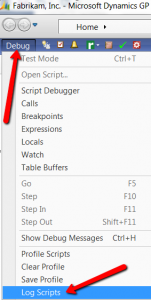No matter which support organization you contact with a software problem, you may occasionally stump the technician on the other end of the line. In these situations, you may be asked to provide a “script log” to help troubleshoot the problem.
A Little Background:
There are many types of log files, such as DexSQL logs, SQL Profiler trace files, and Windows Event logs; they all contain different types of information. Sometimes one log is appropriate when another is not. Your support technician will let you know what type of log is needed.
A script log is a text file that lists all of the procedure calls that are being executed as the software runs inside of Microsoft Dynamics GP. This can be invaluable to a developer who may get called in on tough cases because he/she can compare the calls in this script log to the calls in their program source code. This will likely allow them to determine, with quite a bit of precision, what the program is doing behind the scenes.
Creating the Best Script Log:
The general idea in creating an efficient script log is that you want the log file to be as small as possible. At first, this may seem counterintuitive; after all, why not give as much information as you can? The reason is that these logs generate tons of data. If you can narrow down the log so that it contains just the activity that causes the error to occur, then you will save your support technician from having to slog through pages and pages just to find where to start looking. For this reason, there are three very important things to keep in mind when creating your log file:
1. Begin logging at the last possible moment before the error occurs.
2. While logging is active, perform the fewest possible actions necessary to make the error happen.
3. Turn off logging as soon as possible after the error occurs, without doing anything more than is absolutely necessary in the application.
Following the above guidelines will, in most cases, give the support technician exactly what they need to quickly isolate where in the software the error is occurring.
Three Ways to Create a Script Log:
The three methods for creating a script log that I will mention here are the Software Debugging Tool, using the built-in scrip logging facility in Dynamics GP, and starting script logging at the login.
Software Debugging Tool:
You may be aware of the Support Debugging Tool (SDT) that was created by David Musgrave many years ago. This tool is a wonder, and it can provide many types of logs, including a script log. I will not go into details on all of the ways to set up the SDT to generate a script log, but suffice it to say that if you are familiar with how to use this tool, it is probably the way to go.
The Built-In Script Logger:
Dynamics GP has a built-in way to create a script log (actually, it’s Microsoft Dexterity, but we can ignore that detail here). It’s normally hidden, so you just have to know how to access it. One advantage of using this method is that there is no need to install any other software to use it. I also find it, conceptually, the simplest method.
To make this functionality visible, first exit Dynamics GP. Then edit your Dex.ini and add the following line: ScriptDebugger=TRUE. Note that the case of the letters is important, so be sure to copy this line exactly as it is here.
Tip: Someone before you may have already added this line for some past situation. For this reason, I recommend that you first search your Dex.ini for the text ScriptDebugger. If you find it, and it has a value of TRUE, then you are good to go. If the value after the ‘=’ is anything other than TRUE, then set it to TRUE, save, and close your Dex.ini.
The next step is to log back into Microsoft Dynamics GP. You will now notice that there is a  Debug menu in your toolbar area at the top of the window (see the image at right). To start logging scripts, choose Log Scripts from the Debug menu. Of course, keep in mind the three crucial steps in the Creating the Best Script Log section (above), when determining when to start logging scripts.
Debug menu in your toolbar area at the top of the window (see the image at right). To start logging scripts, choose Log Scripts from the Debug menu. Of course, keep in mind the three crucial steps in the Creating the Best Script Log section (above), when determining when to start logging scripts.
You will be presented with the “Save Script Log as:” dialog. Browse to a location where you would like to save the script log (your Desktop will do). You can leave the default log file name (Script.log) or change it to something more descriptive. Then click Save.
At this point, everything that you do in Microsoft Dynamics GP will be logged to the file that you just specified. This is why you should not start logging until the latest possible point before the error occurs. Of course, if the support technician gives you specific instructions for where to begin logging, then follow those instructions, by all means. But in the absence of that, you should try to start logging as late as possible.
Once the error occurs, then stop logging by again choosing Log Scripts from the Debug menu. In some cases, you may not be able to choose this option because there is some error message or other dialog that is requiring you to respond to it. Go ahead and respond. Then turn off script logging at the earliest opportunity. Again, the objective is to put as little as possible in the log file, so don’t do anything that’s not absolutely necessary before you stop script logging.
Tip: It is a good idea to keep good notes for everything you did and what happened while script logging was active. This will also help your support technician understand what they will be seeing in the log that you are sending them.
Starting Script Logging from the Login (Rockton Software Products Only):
Every once in a great while, you may be asked to start logging at the earliest possible point after you have successfully logged in. This may be necessary if the problem is occurring before the user would have a chance to select anything from the Debug menu. Rockton Software’s products provide an easy way to start logging at this point automatically. Simply open the product’s Setup window, click the Troubleshooting tab, and then choose the Enable Script Logging option. Once you have done this, exit Microsoft Dynamics GP, and then log in again. For this next login only, a script log file will automatically be created in the Dynamics install folder and it will be named as follows:
Product_Script.log
where Product will be an abbreviation of the product that you are logging:
RSA = Auditor
DRM = Dynamics Report Manager
RSOP = Omni Price
SF = SmartFill
RSTB = Dynamics GP Toolbox
For example, the script log file for SmartFill would be named SF_Script.log.
Once you are ready to turn off script logging, you can either choose Disable Script Logging from the product’s Setup menu or simply press Ctrl + Alt + Shift + D.
We want your feedback!
Please let us know if there is anything in this article that can be made clearer, or if you have any other information that would be pertinent to this topic. If there are other, more technical subjects relating to Rockton Software’s products that you would like me to write about, I’d love those suggestions as well.






